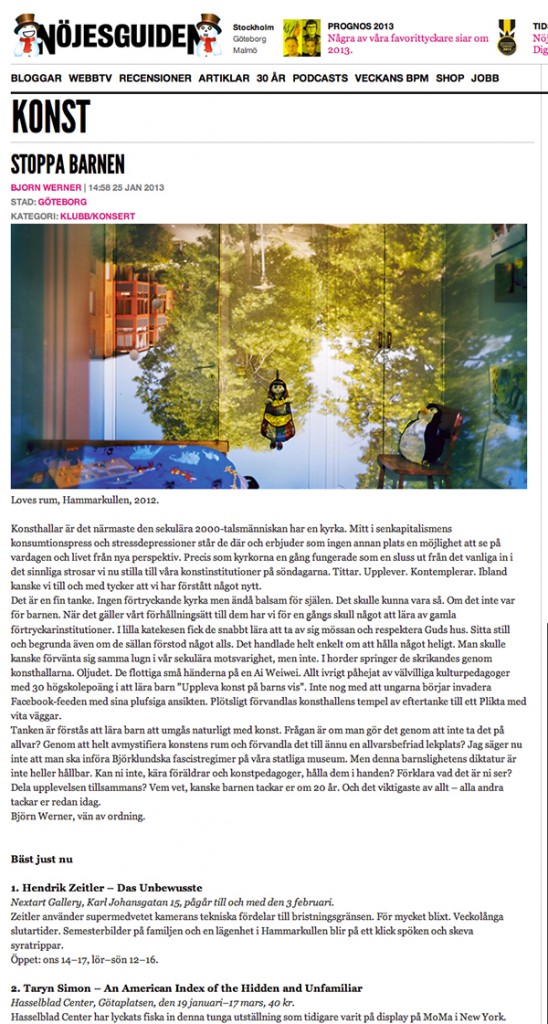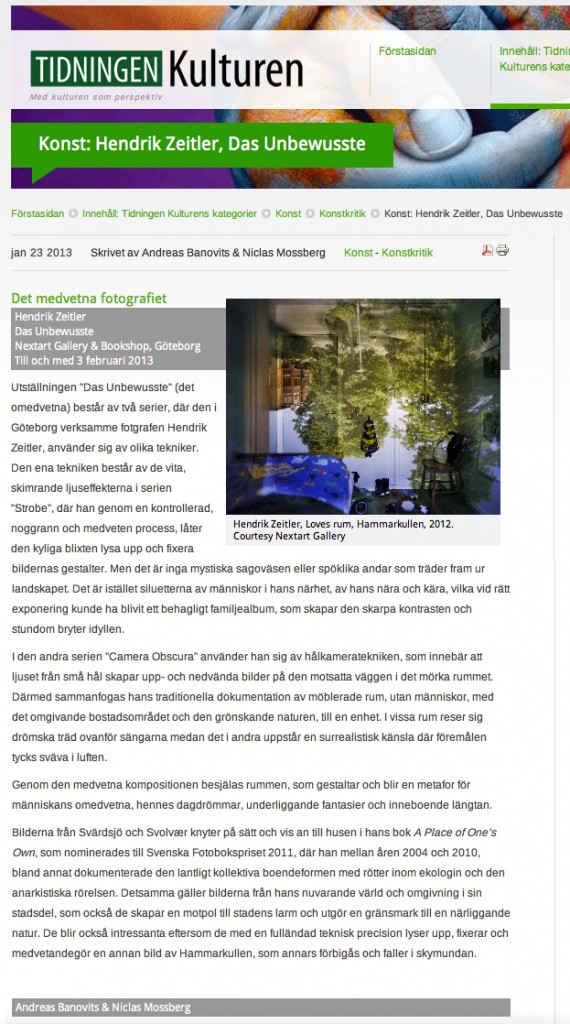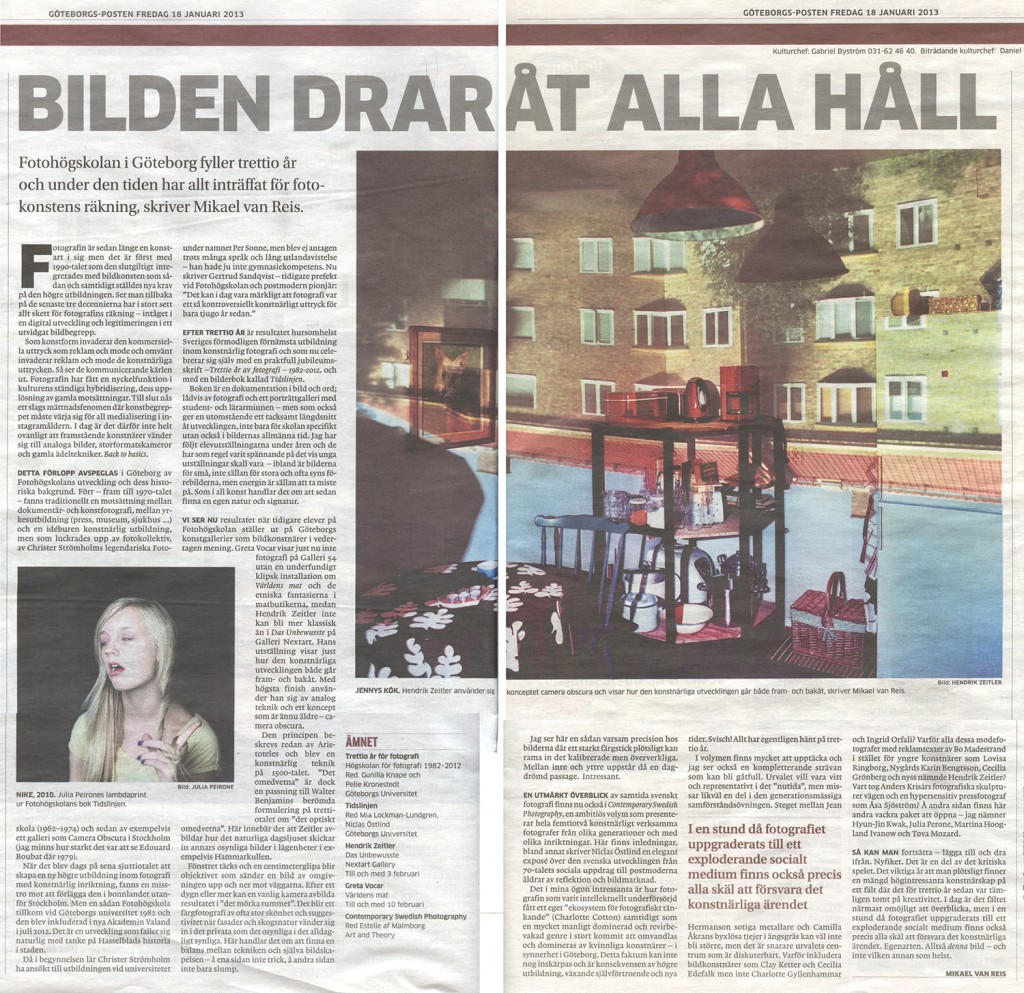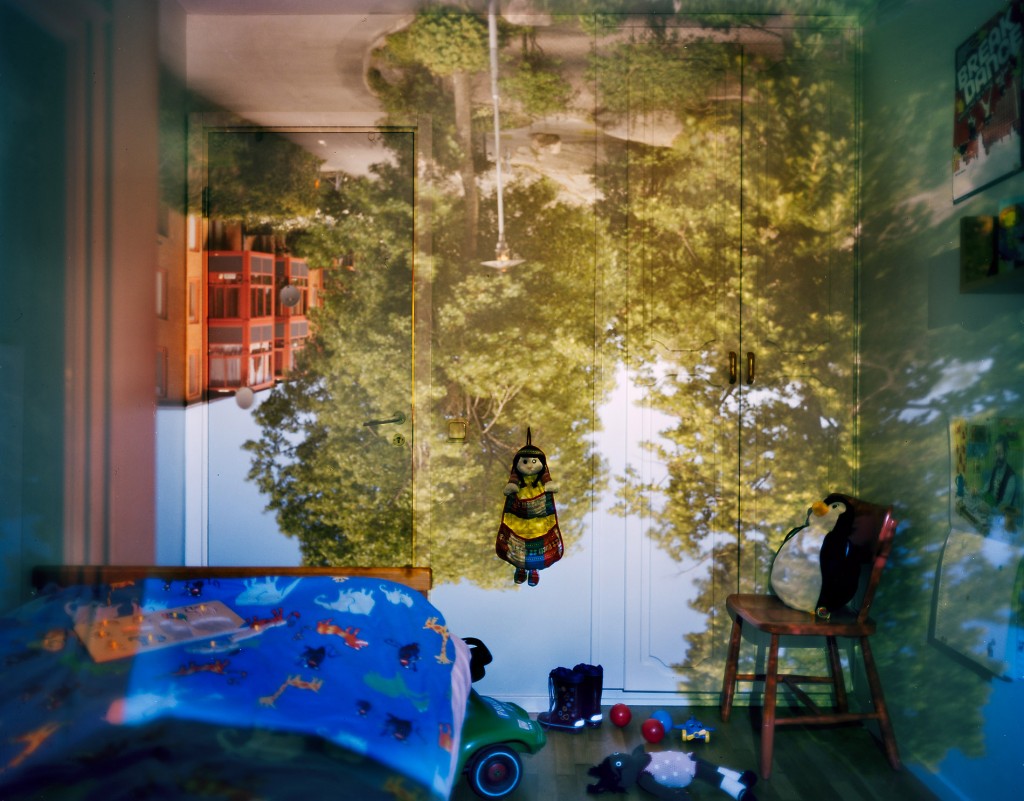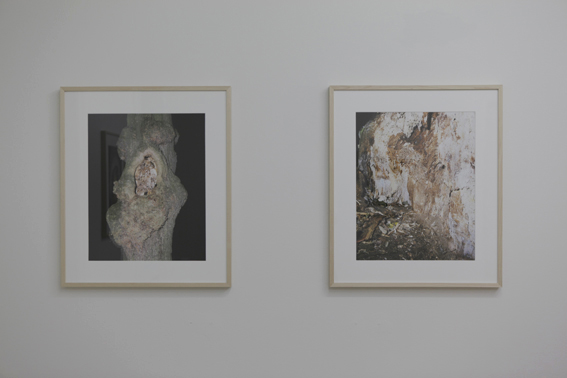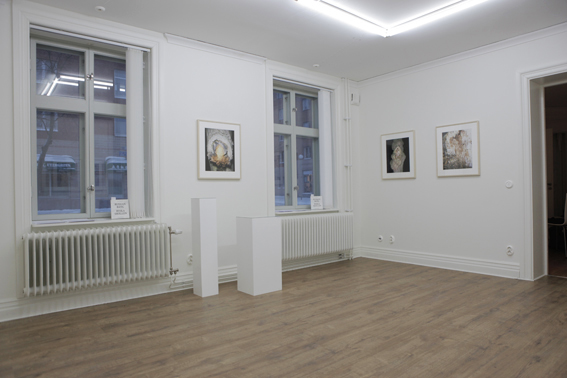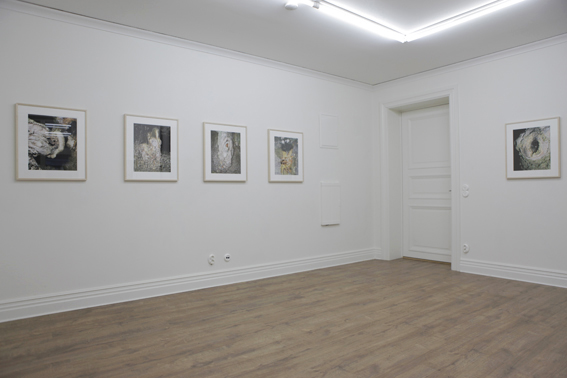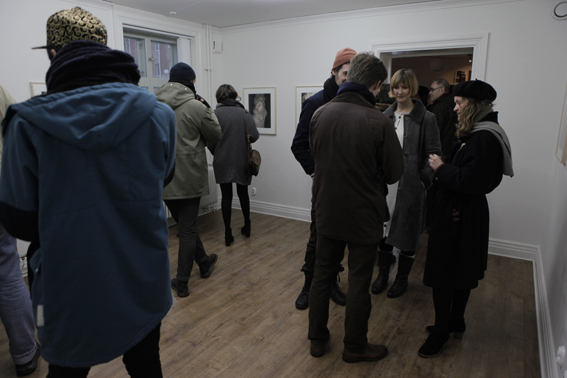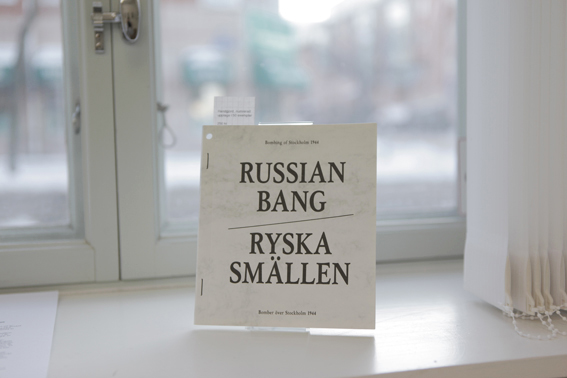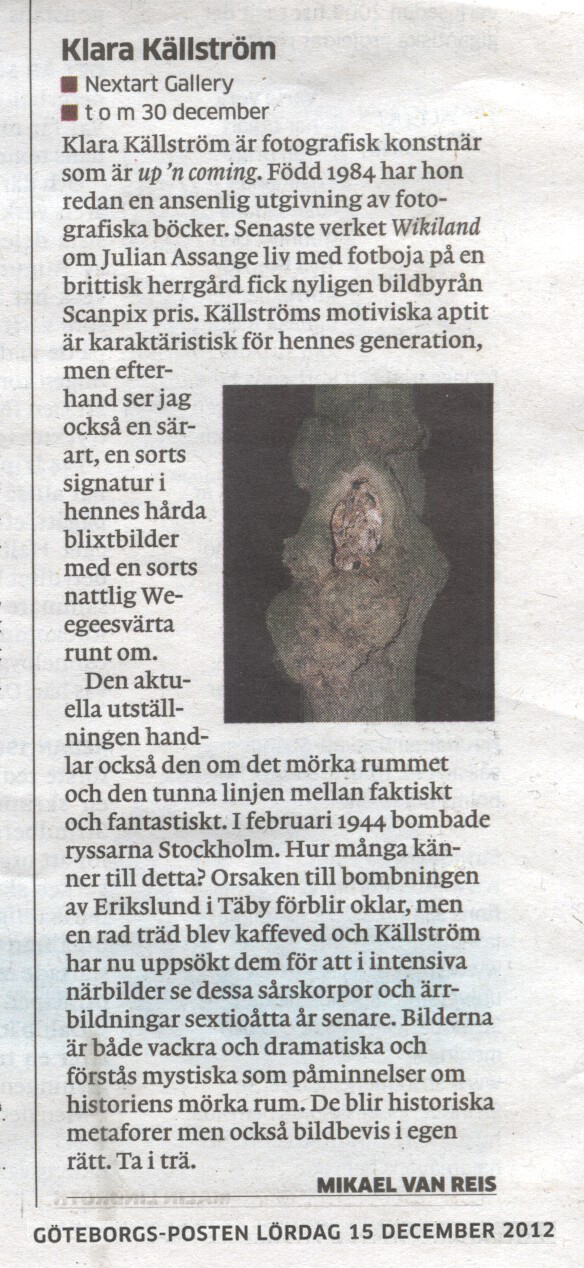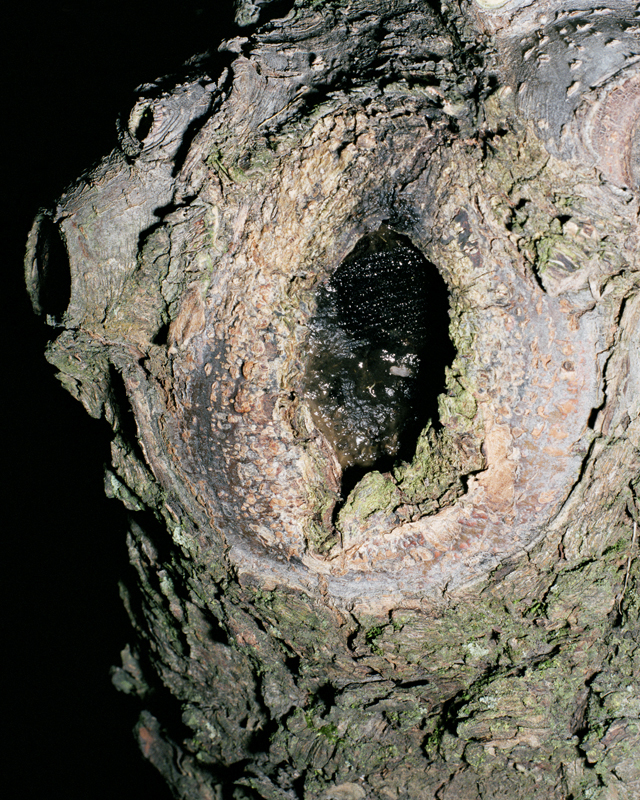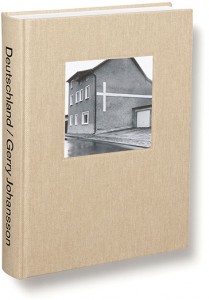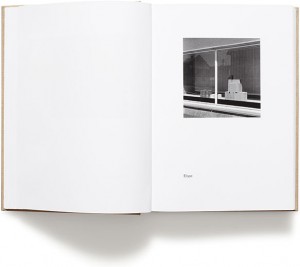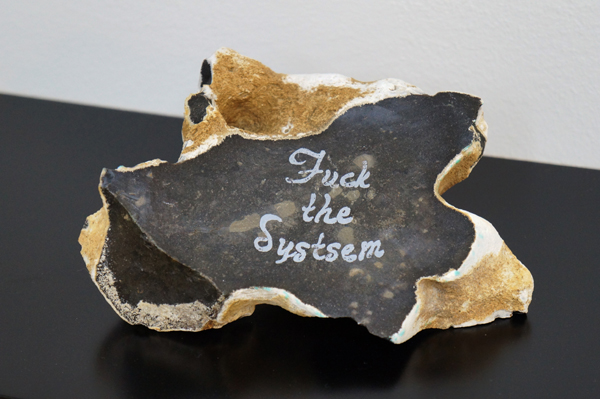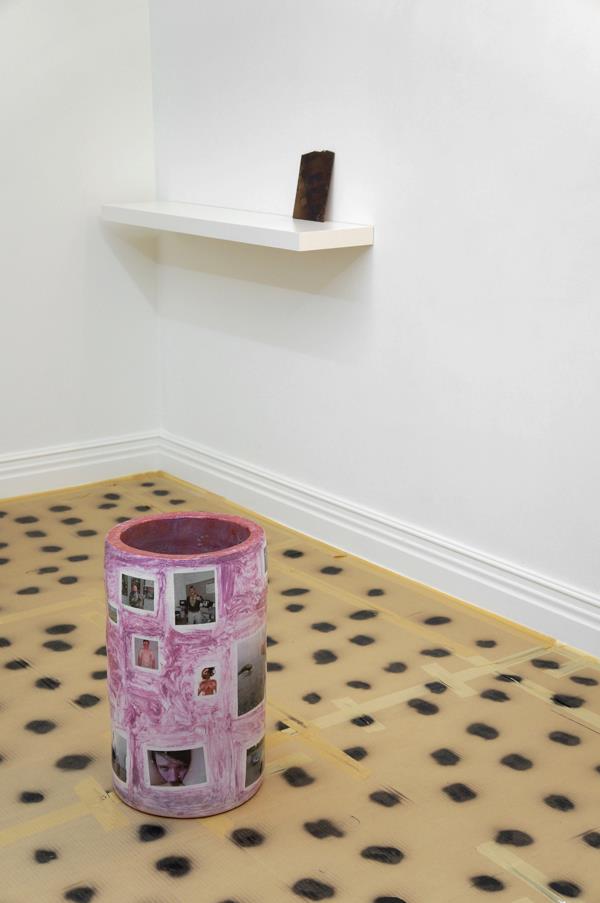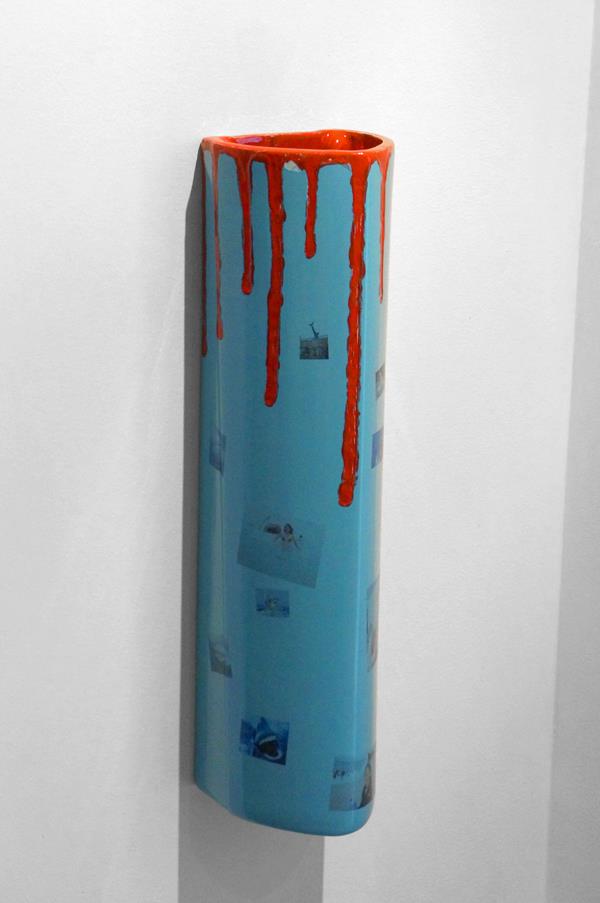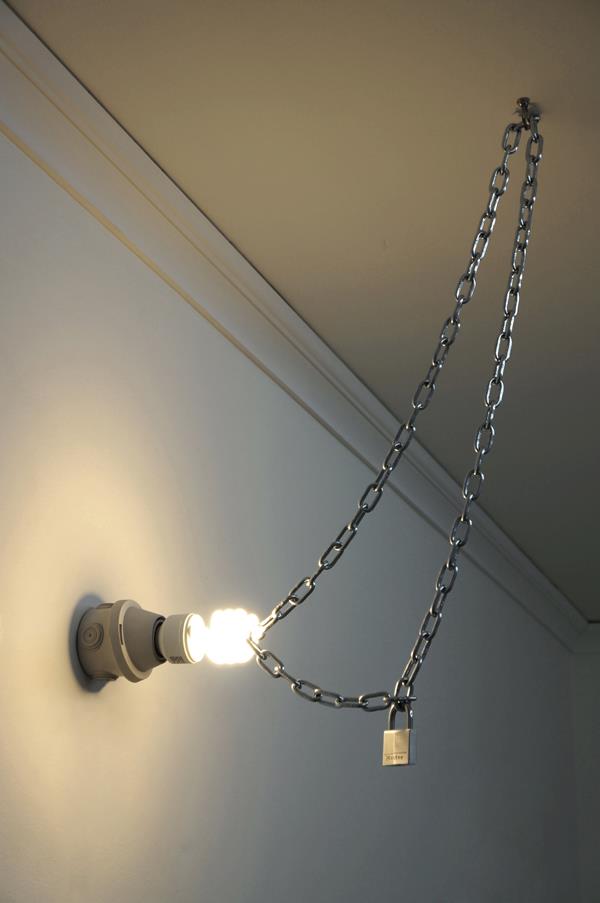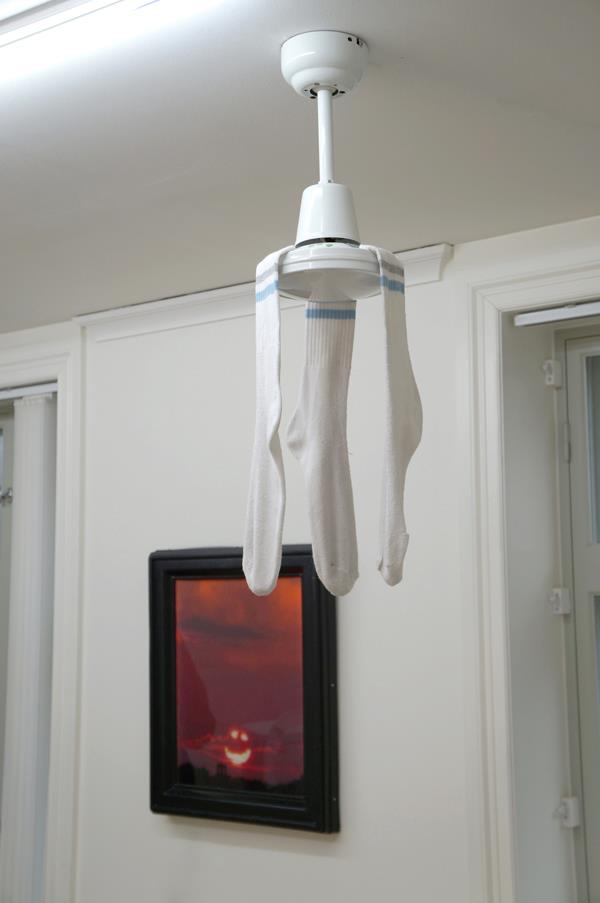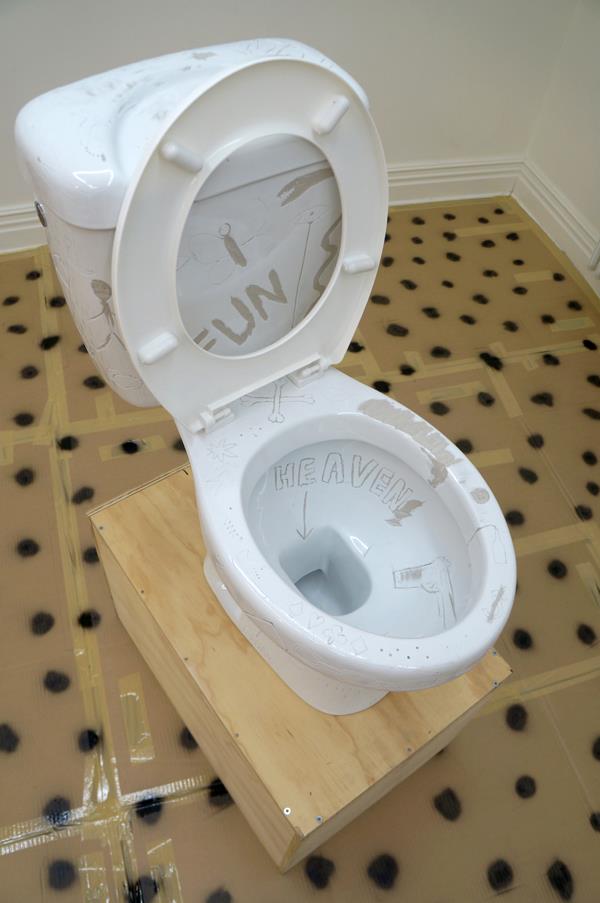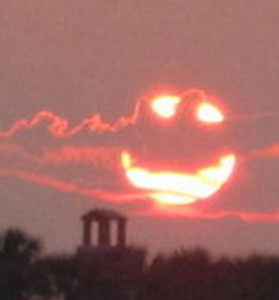
|
|
|

|
|
Press Release Hendrik Zeitler “Das Unbewusste” Opening 12 January 2013 kl. 2-6. Exhibition runs until 3 February. A photo can pay attention to a detail, an event, which we would not have recognized if it hadn’t been photographed. Antonioni’s movie ”Blow-Up” illustrates this phenomena in a brilliant way: a photographer finds traces from a crime first in the darkroom. A woman and a man’s brawl in a park indicate a possible murder. Hendrik Zeitler’s new exhibition ” Das Unbewusste” (the unconscious) which is shown at Nextart Gallery, highlights photography’s ability to capture events that we probably wouldn’t have seen if it wasn’t for the camera. The exhibition title refers to the concept “The Optical Unconscious” which was coined by Walter Benjamin in the essay “The Work of Art in the Age of Mechanical Reproduction”. Benjamin aims in this case on the camera’s clarifying capacity: that it can discover things we otherwise would have missed. ” Das Unbewusste” presents two series. ”Strobe” revolves around random mistakes in the photo production, such as a rain drop or an umbrella tip that has been caught in a close up. The chilly white flash runs through all the images and the photographs adopt an almost abstract character. The pictures otherworldly excitement clashes against the family-based motives. The artist is portrayed with his loved ones, out in the nature, on trips or around the home, like a part of a family album. However, the direct presence which photos of this kind usually provide is absent. Instead, we are reminded of the temporal space that exists between the portrayed and us, a frozen and remote moment. In the ”Camera Obscura”-series, Zeitler has remade whole rooms into pinhole cameras and allows the exposure time to delay, sometimes up to a week. This method reveals images that we wouldn’t have seen with our own bare eyes, and they form coexisting patchworks of environments, colors and cormorants. Most of the photographs are taken in Zeitler’s family apartment in Hammarkullen, a residential area characterized by much greenery. The lush vegetation spreads into Hendrik’s apartment, a kaleidoscopic result of the pinhole camera. The camera’s mechanical limitations and possibilities work like a connective link between the “Strobe” – and the “Camera Obscura”-series. On the other hand, the photographs evoke existential thoughts that seem far away from those technical perplexities. They make us think of time, space and life. Hendrik Zeitler (born 1975) received his Master-degree at the School of Photography in Gothenburg 2003. Zeitler has also studied Gender Studies at Gothenburg University and Art and Architecture at Royal Academy of Arts in Stockholm. His art has been exhibited in both separate – and group exhibitions as Art museum at Abecita Corsettfabrik, Borås and Gothenburg’s fourth International Biennial for Contemporary Art. His book “A Place of One’s Own”, which can be purchased in Nextart’s Bookshop, was nominated for the Swedish Photo Book price in 2011. For more information and press images please contact Sara Arvidsson +4670-940 81 18 or sara@nextart.se
Loves rum, Hammarkullen, 2012, analog färgkopia från 4×5″-negativ, ramad.
|

|
|
Interview with Klara Källström During our meetings, we have talked some about the genre classifications in photography. It still seems relatively easy to revolt against conventions in the world of photography. Why is that? The photograph has for a long time had a position as undisputed truth bearer, which in some way is still valid. Since the postmodernism, and in some cases even earlier, has this position been questioned. Photography is a young form of expression. The color photograph advanced into the history, on a broad front, only fifty years ago. Above all photography is a media consisting of many different genres, and the discursive analysis has challenged the question about what may be called what, and therefore many truths have been turned upside down. In a way, we are still there, in the being of formulation. But I don’t longer believe there is a meaning to reject everything that has something to do with the history of the medium and refers to that which is essential photographic. Instead, we now find ourselves in a place where we can recognize and make use of the medium’s various meanings and add new elements to expand and understand it, instead of neglect or disprove its validity. Due to photography’s young age, it has been important to revolt against its conventions in the second half of the 1900’s, exactly the same way that painting has evolved, the difference is maybe that the latter medium has had more time progress. Do you think these differences and contradictions in photography will consist? I believe that there always will be rebellion in every media. Photography’s rapid technological development contributes to the many and frequent revolts. However, I do not think our perception of the photograph has changed as fast as the physical aspects. The human psyche and our understanding of how photography works and what limitations it might have, is different from how the technology works. On an intellectual level, we constantly have to catch up with the media. I think we on a mental plane have a special understanding of photography and we attribute the medium qualities based on this understanding. However, this approach is of course also changing. If you in a few years from now asks a person, who has grown up in a more seamless environment and has grown accustomed to 3d animated images and their transparency , about an image that is not necessarily taken from the physical reality, I think you would get a different answer. You run B-B-B-Books with designers 1:2:3 and photographer Thobias Fäldt. Thobias and you often collaborate and together you created the project and publication Wikiland, which was awarded at Scanpix Big Photo Award. In this you play with news journalistic strategies, but you choose to omit the sensations and the portraits of Julian Assange are absent. Why did you decide to design the project this way? Is it that important to question the image of photography’s truth-bearing relevance? It is not important to question its truth-bearing relevance, but it’s essential to consider how photography of this kind works and what it produces. When we partake in things of relatively sensational dimensions, something happens with the viewer. It’s the interest in this expectation that is central to the project. Not whether the pictures are true or not, it is a discourse that I think we can leave from now on. What the images are producing and how we thereby filter things that are presented to us, this I think is interesting. Nor do I believe the physical experience is only an outcome of the interaction between the viewer and the story, but also a result of the shape you view the images through. In this case, for example, it was important to use a newspaper format which has its own agency and thereby creates conscious or unconscious understanding of the story. Everything acts on different planes and the human intellect alone is not always essential for the understanding. Tell us a bit about “Russian Bang” that is currently exhibited at Nextart Gallery. Russian Bang is a project where the trees in the devastated area around Eriksdal are ascribed the role as eyewitnesses. I assume that the trees witnessed the event in 1944, when Russian planes bombed Södermalm in Stockholm. I use the usual method; conversation with survivors of the time, which in my case consists of 11 trees. On them and the black backgrounds, I’m projecting the story, which in my case consists of a text in verse form and one archive picture of the site were the bombs once fell down. In what way does this project differ from your other works? It does not differ much from Wikiland, I might say. Russian Bang is about “washing the vision”, to put the viewers in a position where they start looking for what a title, an archive, a poem and a descriptive text refers to. The pictures are affected by the context: we interpret things in the photographs that really just depict seemingly ordinary trees. I have tried to portray the trees in a human-like manner, to assist the viewer in a direction from which I want them to look at my pictures. In Wikiland, our direction was the opposite: the viewer was supposed to have a preunderstanding of the subject, and that this would create the stories. But the connection between these projects is their allusion on preunderstanding or incomprehension. That’s basically the same starting point I think.
|

|
|
Opening hours during Christmas holidays
|

|
|
|

|
|
|

|
|
Pressrelease Klara Källström ”Russian Bang: Bombing of Stockholm 1944” Opening December 8 2012, 2-6 pm. Exhibition runs until the 30th of December. What actually happened that night between 22 and 23 of February 1944, when Russian airplanes swept over a sleeping Sweden and dropped bombs over Stockholm? The event usually referred to as the “Russian Bang”, is a mysterious incident that few know of or remember. No fatal injuries were found, however; the bombs hit buildings and several trees. No obvious reason behind the attack has been identified, although the theories are numerous. The unsolved mystery serves as a catalyst to Klara Källström’s new photo project “Russian Bang: Bombing of Stockholm 1944”, which is premiere shown at Nextart Gallery in Gothenburg. Källström seeks out trees in the affected areas – they act like eyewitnesses – in search of possible clues. Nocturnal landscapes are lit by the camera’s strong flash and the exposed branches and stems are examined with intrusive precision. “Russian Bang” illustrates how the power of preconception forms the actual watching. As in “Wikiland”, which Klara published in cooperation with photographer Thobias Fäldt and 1:2:3 and for which Källström and Fäldt were awarded at Scanpix Big Photo Award, the project emphasizes how easily perception is influenced by an indicative guideline. In “Wikiland”, Klara and Thobias are following the famous Wikileaks-leader Julian Assange, but the intimate portraits of Assange never appear. The connection between the content and the title is not crystal clear. We are reminded of photography’s subjective and ever-changing nature and how images combined with texts have been used as manipulative tools. “Russian Bang” is the first part of an ongoing photo-project based on Swedish myths that Källström has initiated in collaboration with Fäldt. The exhibition presents 11 tree-portraits in color. A new publication, published by B-B-B-Books, is also launched at the opening. In this piece of printed matter documentary footage is intermingled with fictional interpretations in verse, written by a so called mythographer. The publication is issued in a limited edition of fifty copies. Klara Källström (born 1984) has after the examination at School of Photography, in Gothenburg 2009, exhibited her work in both group –and solo exhibitions. The latter category includes exhibitions at the Swedish Institute in Paris, Swedish Museum of Photography in Stockholm and The Popular Workshop in San Francisco. Klara has also created the art at Danderyd hospital’s tube station in Stockholm. Together with Thobias Fäldt and the designers 1:2:3, she runs the publishing-company B-B-B-Books, where many of her photo projects have been published. All book titles from B-B-B-Books can be purchased in Nextart’s bookshop. For more information or press images, please contact Sara Arvidsson at +4670-940 81 18 or sara@nextart.se
|

|
|
We have signed copies of Gerry Johansson’s Deutschland. Deutschland is a visual encyclopedia, a catalogue of the rural and urban landscapes of Germany arranged in alphabetical order. In carefully structured greyscale images, Johansson sensitively explores German history through its landscape, picking out the industrial scenes, industrial buildings, residential roads and shop fronts. His quiet photographs are carefully constructed, grid patterns recur constantly and each frame is packed with information. MACK Books
|

|
|
|

|
|
Press Release “FUN ACADEMY”- Thomas Mailaender FUN ACADEMY is Thomas Mailaender’s first Scandinavian show. The exhibition contains a variable list of works: clumsily executed pottery, a tattooed toilet, floor paintings and much more. Internet and flea markets are important sources of information for Mailaender, which can be seen in his arrangements of images and the aesthetic randomness that these provide. It’s not always the separate pictures or objects that are of importance here, but rather the strange clashes that occur when the photographs or objects meet. A process that is reminiscent of how internet surfing affects the perception – a modern form of surrealism or dadaism. In ”THE FUN ARCHIVE”, Mailaender has stored images of various types. Here the cute and naïve subject matter is juxtaposed with the tasteless and grotesque. From this archive, the artist also found material to the newly produced tapestry ”Image Bondage”, which has been designed with Nextart’s gallery space in mind. With needle and thread, the images have been combined into a grand collage, reminiscent of a contemporary Frankenstein’s monster. Moreover, Mailaender presents the slideshow ”Decisive Moment” – a loose and emancipated tribute to the old, French photographer Henri Cartier-Bresson. Thomas Mailaender (born 1979) is living and working in Paris and Marseille. His works have been exhibited at solo-exhibitions in Paris, London and New York. Mailaender is educated at Ecole des Arts Décoratifs de Paris (ENSAD) and has produced several books.
Welcome! For more information and press images please contact
|
© 2014 Nextart Gallery & Editions / Contact us
